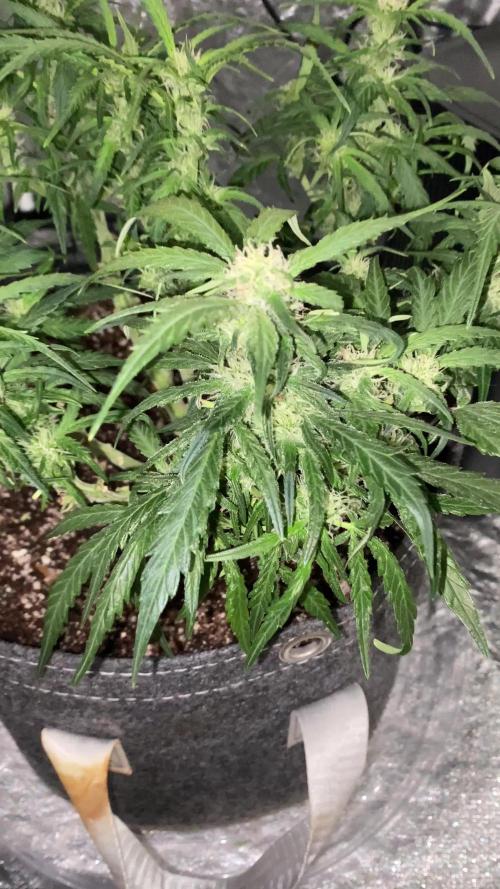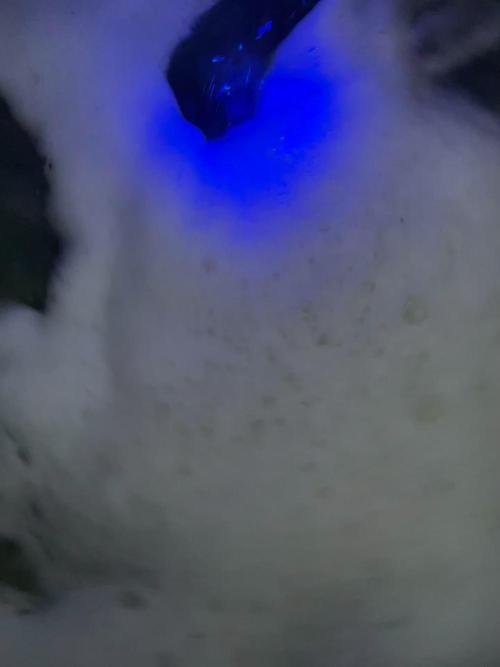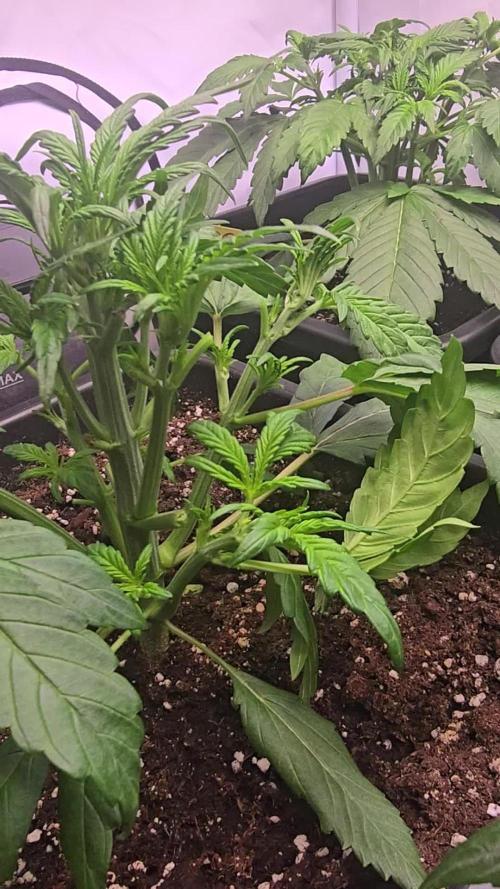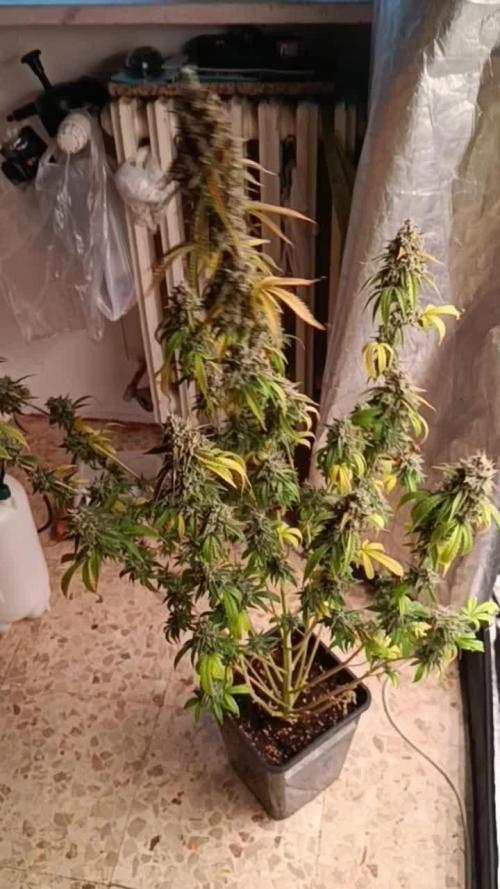The Grow Awards 2026 🏆 



































Likes
25
Share


@Luna91
Follow
Hey There!
Nothing much to say,GOD I can’t wait to taste them!!!! Smell of pineapple is all over my room!! Look at the Digital Microscope!! I know I have at least two more weeks to go!! But simply cant wait🤣 this is my first grow! I studied a lot to make these autoflowers sth worth my time!
Processing
Likes
5
Share


@Cousinrandy
Follow
repotting to 11 liters..needed to be done...right in the heatwave...
i lost a few pounds
Likes
7
Share


@DaddyPrime2
Follow
2/12/25
top dressed with 2 tsp grow 1 tsp microbe and 2 tsp bloom.
this genetic is always sooo freaking frosty. shes already starting to frost up on the fan leaves.
finally looking like shes in flower. it took her awhile to get started i feel like compared to past grows/ other Cultivars.
2/18/25
she has a very nice and even structure to her. a bunch of tops that are 3-5 node top colas with a nice disconnected set of buds after an inch two space between the nodes.
frosty gassy and fairly large considering pot size.
Likes
8
Share


@Chubbs
Follow
Weekly update on these gorgeous girls. Was gone for 9 days so wasn't sure how they'd look when I returned. Wow did they take off into full flower. They're all looking amazing, it looks like two different phenos which is awesome. Over all excited to see them progress as the flower period just started.
Likes
13
Share


@russrahl
Follow
Had a bumpy week this week a little bit, started to get a bit to cold I think at night and this combined with a nitrogen abundance made her slow glowing this week. She’s coming around now though, just diluted my water/nutrients mixture in half and left her be. Got my AC exhaust from one of my flower tents pulling through this tent now so the temps are back up again to normal as well. Be moving her soon to the big tent, I’m guessing a week or so till it’s ready for her. Will be starting lst soon to get her ready for the screen as well, didn’t wanna stress her last week anymore while she was bouncing back still. That’s it for this week. Cheers💨
Likes
18
Share


@Jays_Not_Here_Man
Follow
Week 5 (Day 35) Flower- the week was uneventful. Building stacks, no issues, it’s been rainy here so the humidity has been high, the old dehumidifier is getting a workout 💪 I lowered the light an inch, might not seem like much, but I’ll watch and see if they can handle it. Full feed of nutrients tomorrow when the lights come on😎
Processing
Likes
33
Share


@ThrashedTV_BakedByGlaze
Follow
Start of Week 7! Day 44 - 12/12
Big difference in the two Cali Snow plants!
The centre "Plant 1" is well along in the flowering process with obvious bud sites forming along the small amount of LST I've been able to get going. Got a bit more stretch out of it but it looks like she's settling down but the sativa flowering of this strain is noticeably behind the indica LSD-25 planted same day in my other diary.
The other girl "Plant 2" that is far left and was cooked under the dome early in the grow seems to still be in a pre-flower phase and I'm actually getting a lot of decent stretch/growth in the secondary sites. I'll keep an eye on it for the next week to see if I have to set it off myself with a 12/12 cycle but there are a few pistils here and there. Hopefully it's just a little set back in its timing because it's going to turn out to be the biggest of all 3 plants I have going now. Will have the best veg base for flowering for sure.
Hopefully I won't have to set it to 12/12 and rob the other two plants I have further along in flower of a few hours of light a day.
Gave another feed with upped nutes but still playing it on the low side. Going up a little each feeding and no signs of burn on any of the girls yet. Making sure I'm chasing feeds with plain water and spraying the top layer with plain water here and there to keep any build up at bay; Since the girls aren't big enough for full pot runoff feeds due to small size.
Day 48 - 12/16
You can see how different the timing on the two Cali Snow are. I'm loving the extra time with Plant 2 to set up bigger secondary branches and the pistils still seem to be SLOWLY forming near the top and mature sites. In an attempt to avoid switching her to 12/12 to fully trigger the flower, I've let the temperature drop down a bit to the high teens with the light on by lettering in the winter air and keeping the tent open with lights on. Hopefully the lower temp here and there over the next couple days will get it moving.
Plant 1 is well along in it's flower. The bud sites are well defined and the stretch seems to be wrapping up bringing it in just a bit bigger than my small LSD-25 in my other diary going right now. Pulled it out and reset some new LST on the plant with a less drastic lean. Clipped a few fan leaves and 3 fingers from the two Cali's, anything blocking light or bunching up too much but tried to leave as much as possible for energy production.
The classic Cali Snow smell I was warned about is starting to come in. Even P2 with little to no flowers is throwing off a nice scent. Still tent contained without exhaust for now so no worries on that front.
Day 50 - 12/18
Gave them their biggest feeding today in both nutes and volume. Both split a mix of 1ml each PH Perfect MGB with 1tsp Molasses in a gallon of water with a half gallon plain water chase. First time the plants have been big/thirsty enough for a run-off feeding. Will spray top layer in a day to clean top layer of any residue then top with D-Earth sprinkle to let sit until next feed.
These girls have gone from identical to fraternal twins. P2 on the left is looking more like the plant I wanted in terms of size and spread. The set back in flowering time has really allowed me to train it up and get lower branches up to a pseudo-canopy. It looks like it's FINALLY about to make the final switch as the still bright pre-flower tops are starting to shoot more pistils and new leaf growth has that telltale upward point as the spread comes to an end.
P1 is full flower swing is chugging along nicely as I opened her up main stem up with some selective defoliation and the thin sativa bud structure is slowly but surely coming in. As a new grower, seeing the fatten/faster Indica flower of my LSD-25 right next to the Sativa on the same schedule is a great observational experience. 👽
The smell of the two Cali Snows are finally starting to ripen up. Only chance at smelling my LSD-25 right beside them is to get REAL close.
Thanks for stopping in, throw down a like so I can return the favour, will update through the week! 🙌
IG: @GlazedGrow
Likes
6
Share


@GardenerAP
Follow
She’s starting to produce trichomes all around. This week will be the last feeding and then she will be flushed until harvest. Slight defoliation when needed.
Likes
11
Share


@WhiteWidow
Follow
Perfectly healthy not a single sign of defficiency or burning / overfeeding.
First day of week 2 of flowering, next feeding i will add flowering nutes.
Likes
7
Share


@Huntress007
Follow
So she’s looking good fattening up and looking very healthy! Flowers are forming nicely and are looking beautiful.
Likes
16
Share


@HowtoBubatz
Follow
The Plant is getting very bushy and I am thinking of dedefoliating the plant but I am unsure because of it being an Autoflower in the early stages.
Likes
241
Share


@Tropicannibis_Todd
Follow
💩Holy Crap We Are Back At It And Loving It💩
Growmies we are at DAY 21 and she's just killing💀it👌
So Shit , I gave them just a tad to much nutes 👈 But I have since fixed it
So I'm starting to pull her over and do some low stress training 🙃
Lights being readjusted and chart updated .........👍rain water to be used entire growth👈
👉I used NutriNPK for nutrients for my grows and welcome anyone to give them a try .👈
👉 www.nutrinpk.com 👈
NutriNPK Cal MAG 14-0-14
NutriNPK Grow 28-14-14
NutriNPK Bloom 8-20-30
NutriNPK Bloom Booster 0-52-34
I GOT MULTIPLE DIARIES ON THE GO 😱 please check them out 😎
👉THANKS FOR TAKING THE TIME TO GO OVER MY DIARIES 👈
Likes
31
Share


@Crybabypete
Follow
The buds are beginning to put on some weight and thicken and she is still growing upwards.
I’ve been having to re-tie her every 2-3 days.
Still got a ways to go but I’m really proud of her so far!
Likes
13
Share


@Miketama
Follow
One of 4 strains grown together in 0.36m² using Migro Array 2 (125W). Variable dimming: W1 60%/24h, W2-10-11-12 60%/20h, W3-5-8-9-13 80%/20h, W6-7 100%/20h. Average real consumption: 95W with 173.6 kWh total.
STRAIN: Divine Seeds genetics - underrated
breeders producing excellent quality!
NUTRIENTS: Full Biotabs bacterial line - positively surprised by the results! Organic living soil approach.
GROWING APPROACH: Focused on DLI (calculated from Migro’s PAR map), VPD, water temperature, and water resting time. Did NOT monitor pH, EC, CO₂, or use PAR meter.
MY BEST HARVEST SO FAR! 🏆
COLLECTIVE METRICS (4 plants total):
• Total dry weight: 210g (+ 10g bubble hash)
• Total wet weight: 890g
• g/watt: 2.21 (or 2.31 with hash)
• g/m²: 583 (or 611 with hash)
• Average per plant: 52.5g
Individual weights: Fractal 55g, Northern Lights 54g, Black Opium 67g (best performer!), Moon Rock 34g. Dense and resinous buds.
Additionally grew 3 outdoor plants (Fractal #2: 21g + 60g frozen, Northern Lights #2: 14g + frozen, Black Opium #2: 50g fresh frozen) - not included.
~300g frozen trim (indoor+outdoor) yielded ~10g bubble hash.
Good luck to everyone in the contest! 🍀
Likes
52
Share


@Santica_Garden
Follow
Trying out Green House Seeds newest strain of 2021 KING'S JUICE, also using this as my test grow as I have been growing for 1 year now so I'm going to be putting everything I have learnt throughout the year into practice.
Wish me luck guys & Happy Growing
Any questions just ask 👍🏾💚🌱
Likes
12
Share


@BloodBath
Follow
Everything bounced back to normal. These smoothies want a bit of nitrogen throughout veg. 90% of the time when I have an issue it’s because PH or PPM being too high. This wasn’t the case as I ran two tests on my medium and everything was fine. Once i fed them twice with some higher nitrogen levels and some kelp n algae they bounced back in a week. After the first feeding I could notice a nice green coming back into the leaves. I have not flushed once since then. I’ve been feeding a tea every two weeks instead to break up whatever’s left behind. I plan to do one more feed in a couple days and I’m gonna do a light flush with SLF and then continue feeding nutes and teas until she’s ready to be flushed towards harvest.
Likes
7
Share


@Krissci
Follow
Day 3
1st bit of training this week.
Looking healthy.
My aim is to allow lowest bud sites to keep up with the main heads..
LST LST LST LST LST
During this stage is most important to train Ur plant into the shape u want.
Likes
32
Share


@Ganjagrandaddy
Follow
Day 63 Flowering: Hi all , well here we are, finally at the end of this amazing grow and only the trim and dry before the main event.....The results..
It has been a great grow from the start with these seeds , they have not missed a beat at all.
The #4 has been innthe dark now for the past 6 days to try to really push the oils and survival instinct of the early finishing lady. She will be trimmed tonight as I don't want to push her too far and create a hermie now..
She is nice and sticky now and smells so sweet of fresh cut fruit.
#1 has been ripening for the past week and even has a few new pistils showing up to add to the contrast of colours too her beautifully formed buds. They are so dense and solid to squeeze too. Her trichromes are beginning to show more amber among the cloudy and I don't want to leave her too long and ruin the intended high she naturally allows so it is time to take her out and into a dark period before trim to drying. As they are all grown organically , the need to flush ( bro-science anyway lol) and allow the harshness to go, is less worrisome. I have always dried intact in the past with no cuts to the plant until completely dried. This took care of the chlorophyll hit that often gets missed when drying wet trimmed and leaf gets trimmed into the bud. I also dry slowly to ensure the chlorophyll gets used up and not locked-in to the bud. Spending so long smelling this Mango aroma , it would be wrong to ruin in the harvesting now..
# 2 is my star of the grow so far on this auto perpetual run. She has been a monster from early days and performed perfectly . Her main stem is a total beast and I cannot wait to weigh that alone.. The colours and smell are so perfect too. I think this plant has shown just how capable the genetics are to create a huge plant with very little interference and a normal feeding regime that was simple too. astounding girl. She is a trichrome producing lady too and has some very nice frosting. The pics don't do them justice compared to standing in front of these beautiful plants . Well done Exotic seeds.
I will update as the drying process goes and do a full harvest and report once we are there. be safe and well growmies. Grab yourselves some of these seeds from over at exotic and you won't be dissaointed no matter your growing experience...

















